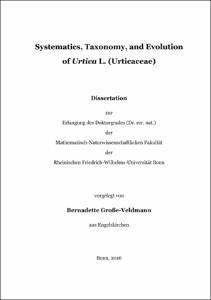Systematics, Taxonomy, and Evolution of Urtica L. (Urticaceae)

Systematics, Taxonomy, and Evolution of Urtica L. (Urticaceae)

| dc.contributor.advisor | Weigend, Maximilian | |
| dc.contributor.author | Große-Veldmann, Bernadette | |
| dc.date.accessioned | 2020-04-23T19:31:26Z | |
| dc.date.available | 2020-04-23T19:31:26Z | |
| dc.date.issued | 25.04.2017 | |
| dc.identifier.uri | https://hdl.handle.net/20.500.11811/7122 | |
| dc.description.abstract | The systematics of Urtica have puzzled scientists for the past 200 years and no single comprehensive attempt at understanding infrageneric relationships has been published in the past, nor have species delimitations been unequivocally established. The major aims of this study are to clarify some taxonomic problems in morphologically difficult taxa with a special emphasis placed on the European, Australian/New Zealand and Asian species. In addition, the overall phylogeny of Urtica based on a comprehensive sampling of the species and subspecific entities in the genus was addressed and based on this, a re-examination of the gender distribution as an important and probably unique morphological feature within angiosperms. Chapter 2 identifies a total of five morphotypes of the widespread and often weedy U. dioica subsp. dioica which are stable in cultivation and usually occur in several different regions of Europe and/or are characterized by some type of habitat preference. Infraspecific relationships of this clade have been further analysed by highly resolving next-generation-sequencing-data in chapter 8. The third chapter addresses a redefinition of U. incisa and allies in New Zealand and Australia, including the segregation of two new species U. sykesii and U. perconfusa. In addition, evidence for the presence of true introduced U. dioica subsp. dioica in New Zealand was found. Urtica from Asia is also plagued with problems in taxon differentiation. Based on a critical re-examination of morphological characters combined with molecular data, a total of four subspecies of the eastern Asian species U. thunbergiana is proposed (Chapter 4) and a total of five species and two subspecies are recognised within the East-Southeast Asian Urtica fissa-clade (Chapter 5). Chapter 6 provides the first comprehensive phylogeny of the genus Urtica including 61 of the 63 species recognized. The phylogenetic analyses retrieve numerous well-supported clades and suggest that the morphological characters used to distinguish and group species in the genus do not reflect phylogenetic relatedness. Eastern Asian Zhengyia shennongensis is sister to Urtica and western Eurasian U. pilulifera and U. neubaueri are sister to all other species of the genus. The evolution of Urtica sexual systems has so far been treated very generically in the literature; this study reveals two entirely different dimensions to this phenomenon – the distribution of different sexes between plants versus the complex geometry of their distribution on individual plants (Chapter 7). Numerous theories have been proposed for the former phenomenon, but the geometry of gender distribution on individual plants has escaped the attention of scientists. We here provide a descriptive and evolutionary framework for gender distributionin Urtica. We found polygamy, two types of gynodioecy and five architectural types of monoecy. | en |
| dc.language.iso | eng | |
| dc.rights | In Copyright | |
| dc.rights.uri | http://rightsstatements.org/vocab/InC/1.0/ | |
| dc.subject | Botanik | |
| dc.subject | Systematik | |
| dc.subject | Taxonomie | |
| dc.subject | Evolution | |
| dc.subject | Ökologie | |
| dc.subject | Botany | |
| dc.subject | Systematics | |
| dc.subject | Taxonomy | |
| dc.subject | Ecology | |
| dc.subject.ddc | 570 Biowissenschaften, Biologie | |
| dc.subject.ddc | 580 Pflanzen (Botanik) | |
| dc.title | Systematics, Taxonomy, and Evolution of Urtica L. (Urticaceae) | |
| dc.type | Dissertation oder Habilitation | |
| dc.publisher.name | Universitäts- und Landesbibliothek Bonn | |
| dc.publisher.location | Bonn | |
| dc.rights.accessRights | openAccess | |
| dc.identifier.urn | https://nbn-resolving.org/urn:nbn:de:hbz:5n-46288 | |
| ulbbn.pubtype | Erstveröffentlichung | |
| ulbbnediss.affiliation.name | Rheinische Friedrich-Wilhelms-Universität Bonn | |
| ulbbnediss.affiliation.location | Bonn | |
| ulbbnediss.thesis.level | Dissertation | |
| ulbbnediss.dissID | 4628 | |
| ulbbnediss.date.accepted | 09.02.2017 | |
| ulbbnediss.institute | Mathematisch-Naturwissenschaftliche Fakultät : Fachgruppe Biologie / Nees-Institut für Biodiversität der Pflanzen | |
| ulbbnediss.fakultaet | Mathematisch-Naturwissenschaftliche Fakultät | |
| dc.contributor.coReferee | Quandt, Dietmar |
Files in this item
This item appears in the following Collection(s)
-
E-Dissertationen (4446)




